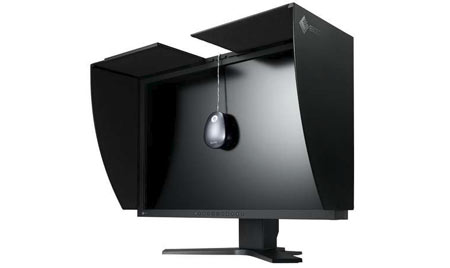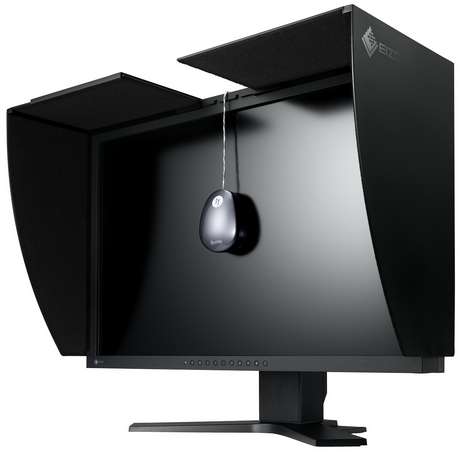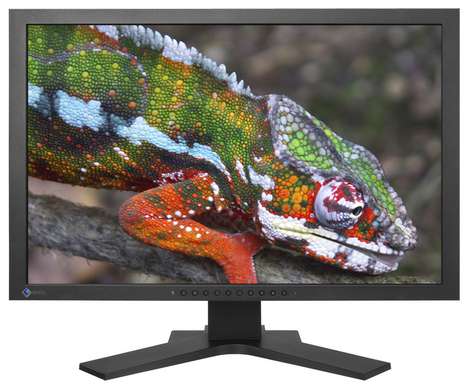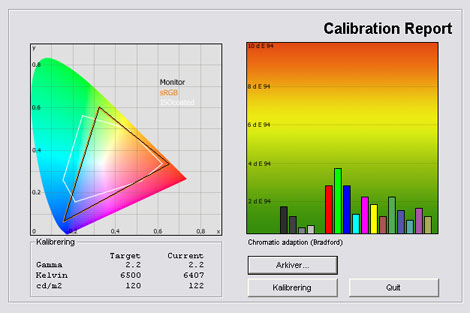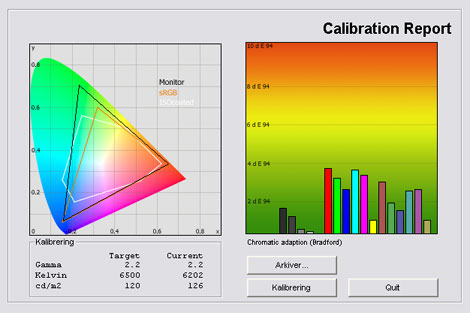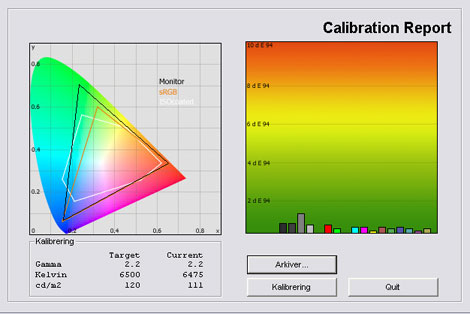Review: Eizo CG243W
Eizo CG243W review
Eizo CG243W is one of Eizo’s monitors from the ColorEdge range that is targeted at serious graphic work and media production. The ColorEdge series has been one of the most acknowledged monitor series for these tasks for years and we are eager to test the 24-inch CG243W that comes with an IPS panel.
Can CG243W provide us with even better results than the cheaper Eizo graphic monitors? And how accurate is it in our picture measurements? Read on to find out in this FlatpanelsHD review.
Subscribe to our Newsletter to get an e-mail when new reviews are online.
Panel size: 24" Resolution: 1920x1200 Response time: 5 ms (g2g) Overdrive: Contrast ratio: 850:1 Brightness: 270 cd/m˛ Colour Support: 16.7 million colours Colour gamut support: 98 % of AdobeRGB Signal processing: 8 bit for each colour Viewing angles (H/V): 178°/178° (10:1) Dot pitch: 0.270 mm Panel type: IPS Wall mounting: Dimensions (HxWxD): 36.7cm x 56.6cm x 8.5cm (without stand) Weight: 10,7 kg Adjustments
Tilt Swivel Height Pivot Built-in speakers: Inputs VGA DVI DisplayPort Audio (type) SCART S-video Composite Component HDMI Other USB hub Price and retailer:
| US retailer | UK retailer |
 |  |
Our first impressions
Eizo CG243W is a typical graphic monitor with a large cabinet that feels robust and stable.The stand has two “legs” and provides a solid foundation for the 24-inch monitor. It allows the user to height, swivel and tilt adjust CG243W.
Eizo has also integrated a pivot feature.
The inputs are located on the back and here we have 2xDVI and 1xDisplayPort.
CG243W also comes bundled with a monitor hood that can help reduce reflections from lamps and windows, and therefore ensure better picture accuracy in different working environments.
The menus have a lot of different picture setting options. First of all CG243W has some different picture presets, pre-calibrated for different tasks: Custom, sRGB, EBU, REC709, SMPTE-C, DCI, CAL1, CAL2, and CAL3.
CG243W also has the following setting options: brightness, contrast, temperature, gamma, hue, saturation, outline enhancer, gain, black level, 6 colors, and a screen size selector.
In the gamma menu you can select; Standard, 2.6, 2.4, 2.2, 2.0, and 1.8. In the temperature menu Eizo has incorporated a 500K increment stair from 10000K to 4000K. Some of the standard color temperatures such as 5400K and 9300K are also selectable.
Energy Consumption
You can see our energy measurements on Eizo CG243W below.| Out-of-Box (gns) | After calibration | |
| Standby | 0,5 W | 0,5 W |
| PC | 70,2 W | 48.8 W |
I measured a energy consumption of 48.8 W after calibration. This is quite high but not unusual with graphic monitors. The NEC PA241 consumed 43.2 W after calibration.
Also, please note that LCD monitors uses less power after calibration. This is common on flat panel displays because many picture parameters are reduced during calibration.
Test tools
We use the DVI input for testing. The graphic card is Geforce 7900GTO.The monitor has been measured and calibrated with a LaCie Blue Eye Pro. We also examine the monitor with the help of our monitorTest. And finally we test the monitor in games, movies etc.
Picture quality on Eizo CG243W
Out-of-box picture quality on CG243 is measured below in the sRGB picture mode.The graph says this:
The number on the left is the delta value. Delta is a difference between two factors; here it’s the difference between the measured colour on the panel and the actual colour that is our target.
The out-of-box result in the sRGB mode is stunning. The color deviations are very low and the gamma is very, very close to our target of 2.2 only varying by 0.01 from the bright grey tones to the dark grey tones. This ensures picture and color accuracy and picture balance.
The color temperature is a bit too low, however, but not by much. Brightness is also very close to 120 cd/m2 which is a typical value in the sRGB standard for dim environments.
Eizo CG243W is indeed a wide gamut monitor as you might have noted by now but Eizo is using a color space emulation to reproduce sRGB and this worked great without any problems (which is very rare with wide gamut monitors). After calibration you can keep the sRGB gamut simply because of the way that the color space emulator functions; it is not based on a fixed color preset.
Install the Color Navigator software that is bundled to get a good software tool for CG243W, too.
Eizo CG243W has a number of different color presets for different working environments including sRGB, EBU, REC709, SMPTE-C, and DCI. I won’t go through all of them but I went on to take a measurement in the AdobeRGB gamut that CG243W also covers (98%).
Below you can see my AdobeRGB measurement.
Again the result is very good and all picture characteristics are impressively accurate. The enitre AdobeRGB spectrum is not covered and there are some missing colors in the purple and cyan missing but the result is good.
Finally I did a calibration (in the Adobe gamut).
After calibration I managed to improve color reproduction even further. CG243W comes pre-calibrated but if you’re working with graphic you need to perform a calibration after some time to ensure correct picture quality.
Eizo has some calibrators for sale on www.eizo.com but you can also use non-Eizo calibrators. We used a Gretag.
My calibrated settings are.
| After calibration | Brightness: | 30 |
| Contrast: | - |
| Temperature: | Standard |
| Gamma: | 2.2 |
| RGB: | Custom |
| • R: | 89 |
| • G: | 80 |
| • B: | 96 |
I did not change much but did a minor RGB calibration.
I went on to check the color temperature presets to see how accurate they were on CG243W:

The result is good. Only some of the coldest color temperatures (those close to 10.000K) have some minor deviations.
And I checked to see if CG243W had accurate gamma in the 1.8, 2.0, 2.2, and 2.4 presets. My measurements were pretty much perfect. CG243W had gamma variations that topped no more than 0.04 in all of the different gamma settings
The color reproduction in practice is impressive. One thing is color accuracy, another is color gradation. In our color gradients we observed pretty much a perfect result. All colors are beautifully distinguished and the only problem is that black depth is not perfect (I’ll get back to that in a moment).
Eizo has incorporated a 16-bit internal color processor to ensure very accurate and distinguished colors and this is certainly a reason for the very good result we observed. We saw no clipping or dithering at all.
The IPS panel is matte and this helps reduce reflections. You can also add the monitor hood to ensure a better performance.
I checked to see if CG243W has the same dirty screen look that most IPS monitors have today. It has and this might annoy some people but the effect is very subtle. An A-TW filter could have helped but Eizo has not incorporated an IPS panel with A-TW filter which is a shame.
Below I have measured black level and contrast ratio:
| Out-of-Box | After calibration | |
| Black level | 0.20 cd/m2 | 0.19 cd/m2 |
| Brightness | 122 cd/m2 | 111 cd/m2 |
| Contrast ratio | 610:1 | 584:1 |
Contrast ratio +/- 50
After calibration I measured a black depth of 0.19 cd/m2. This is not fantastic and black depth is one of the downsides of the IPS panel technology. With the brightness increased to 100 % (220 cd/m2 white point) the black level rose to 0.34 cd/m2
Compared to VA based graphic monitors such as some of Eizo’s own Flexscan/Foris monitors (for example FX2431) that has a black depth of 0.12 cd/m2, CG243W does not reproduce the same deep blacks. Really, this is one of the only critique points with CG243W.
Shadow detailing is good, too. I can distinguish almost all of the dark grey shades and only the 1-2 shades closest to black are crushed.
Finally I've taken a picture of CG243W in a completely dark room to examine clouding / backlight bleeding issues.
Eizo CG243W has no clouding issues whatsoever and this is very positive. This is probably one of the best results from any LCD monitor today. It’s also worth noting that Eizo has a production step called DUE (digital uniformity equalizer) to ensure that backlight uniformity is good enough.
Response time and games
Obviously this is not a gaming monitor but we also include a response time test and CG243W is also targeted at broadcasting and video editing which means that response time is a factor.And CG243W actually has a quite fast response time. Eizo has incorporated an Overdrive circuit and this reduces trailing to that of the Dell IPS monitors such as the Dell U2410.
I saw no heavy trailing on either dark or bright colors and CG243W has no overdrive trailing (halos around moving objects) which is very positive.
All in all a quite response monitor that can easily serve as a monitor for video playback and editing but also gaming if some of you graphic designers are into that.
Viewing angles
The viewing angles are wide and this is a typical characteristic of the IPS panel. Colors maintain intensity from even wide angles and there are no critical issues.The viewing angles are not perfect and contrast is reduced a bit from angles but CG243W has some of the widest viewing angles of a LCD monitor today.
I have taken pictures of the viewing angles below:
Conclusion
Let me start out by saying that Eizo CG243W is fantastic monitor for graphic work - nothing less. The many picture settings options and the very accurate picture presets make it suited for different graphical environments, too. Including media production.Picture quality is fantastic. Color accuracy is close to perfect and I experienced no problems with color graduation in our gradient tests. The backlight homogeneity was 99 % perfect and the viewing angles are fairly wide. The response time is semi-fast and I experienced no Overdrive trailing making CG243W suited for video editing and playback.
On the negative side is the black depth and this is a typical effect of the IPS panel technology. After calibration I measured a black depth of 0.19 cd/m2 which is worse than the VA panels. I would also have liked an A-TW polarizer in CG243W but both factors are not critical at all.
All in all Eizo CG243W really impresses me but the price tag is also high. Not since 2007 have we awarded a monitor with a Reference Award but I will now transfer the monitor Reference Award to CG243W and it will serve as a future reference here on FlatpanelsHD in our monitor reviews.

Press the award logo to learn more.
Price and retailer:
| US retailer | UK retailer |
 |  |
More reviews here. Subscribe to our Newsletter to get an e-mail when new reviews are online.
| Pros | Cons | Target group |
| Picture quality | Black level | Graphic |
| Color accuracy | No A-TW filter | Video editing |
| Picture settings options and presets | Price | Post production |
| Perfect backlight homogeneity | Office | |
| Response time |

